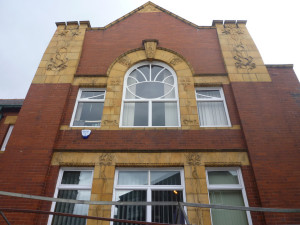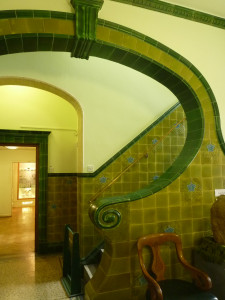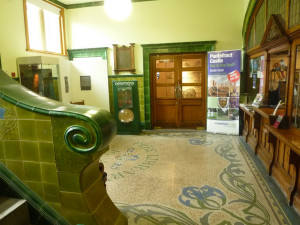Written by Karoline Schwenker
 It is impressive how an art movement not only influences countries individually, but also creates connections between countries that one might not necessarily expect. This is true of the Art Nouveau movement that occurred between 1890 and 1910. There are the obvious connections, such as designs infused with Asian or Middle Eastern style. It is also known that many architects of the movement travelled throughout Europe, which influenced their designs and techniques. However, another aspect that would connect countries together was the construction of Art Nouveau style buildings; for, these required a source of funding, an architect, and a chosen location. Naturally, it was not always the case that all three were found in the same country. A perfect example of this is the construction of the Pontefract Museum in Pontefract, UK.
It is impressive how an art movement not only influences countries individually, but also creates connections between countries that one might not necessarily expect. This is true of the Art Nouveau movement that occurred between 1890 and 1910. There are the obvious connections, such as designs infused with Asian or Middle Eastern style. It is also known that many architects of the movement travelled throughout Europe, which influenced their designs and techniques. However, another aspect that would connect countries together was the construction of Art Nouveau style buildings; for, these required a source of funding, an architect, and a chosen location. Naturally, it was not always the case that all three were found in the same country. A perfect example of this is the construction of the Pontefract Museum in Pontefract, UK.
In 1895 a proposal was put forward to build a Free Library in Pontefract. However, when the local residents voted, only 150 out of 850 people voted in favour of its construction. This all changed when in 1902, Andrew Carnegie was approached by the Town Clerk regarding funding for this Free Library (wakefield.gov.uk). Carnegie was born in Dunfermline, Scotland, but moved to the United States when he was thirteen. While there he worked his way through the American industrial sector and emerged a steel tycoon. During his time, he was one of the wealthiest men in the world, as well as one of the greatest philanthropists in the world (philanthropyroundtable.org). Carnegie believed that those blessed with wealth had an obligation to give away their money for the benefit of the community. Naturally, each person must provide for his or her family, but any additional funds should be used to help “poorer brethren” (Carnegie 2006). As Carnegie reasoned, the rich made their wealth through the working of those in poorer situations. If the wealthy do not give back to their workers and the community, then social frictions will increase. Of course, the money could not just be handed out to the masses. Carnegie wanted to ensure that the money would be going towards the betterment of society and not wasted. One of his favourite ways of giving back to the community was through the building of Free Libraries. As a young man, Carnegie had the opportunity to use the library of Colonel James Anderson who made it open to working boys (philanthropyroundtable.org). This obviously had a lasting impression on Carnegie. By the end of his life, Carnegie had spent over $56 million to build about 2,509 libraries (pontefractus.co.uk).
So it came to be that a Scotsman who moved to the United States became the founder of library in Pontefract, UK. Of course, Carnegie would not have agreed to fund the project unless a plan for construction and maintenance was in place. This is where the architect George Pennington steps into the picture. Pennington started an architectural firm with Samson Howard Garside in Castleford, but moved the business to Pontefract in 1901. This proved to be a fortuitous choice, for it was only in 1903 that the firm submitted designs for the new Free Library. The plans for the building were accepted by the City Council, which could be in part due to the fact that Pennington offered the firm’s plans and services free of charge. The only piece left was to bring in Henry Gundill to provide the supplies for the building’s construction (wakefield.gov.uk).
 Although the library was converted into a museum after new library facilities were constructed in 1975, the original building still retains its Art Nouveau features. Pennington had been greatly influenced by the Art Nouveau movement and incorporated free flowing shapes and organic forms into his designs. These designs would not still exist today if it were not for the work of the Pontefract Museum curator Richard Van Riel. Van Riel used the early design plans of Pennington as his guide. Not only did he remove paint from the tiles and reposition doors, but Van Riel also replaced missing handles and reconstructed features that were in Pennington’s original plans. For example, each of the door handles was a unique design and could not simply be replicated from a pre-existing one. Van Riel had to locate a company that could specially cast the handles according to the original specifications. Other reconstructions were the curved oak reception desk and the iron railings outside the entrance to the building. These iron railings are particularly interesting because they were not actually realized when the library was opened in 1905. Van Riel included them in the restoration in order to replicate Pennington’s initial vision for the building, as these railings were part of one of the first design plans (pontefractus.co.uk).
Although the library was converted into a museum after new library facilities were constructed in 1975, the original building still retains its Art Nouveau features. Pennington had been greatly influenced by the Art Nouveau movement and incorporated free flowing shapes and organic forms into his designs. These designs would not still exist today if it were not for the work of the Pontefract Museum curator Richard Van Riel. Van Riel used the early design plans of Pennington as his guide. Not only did he remove paint from the tiles and reposition doors, but Van Riel also replaced missing handles and reconstructed features that were in Pennington’s original plans. For example, each of the door handles was a unique design and could not simply be replicated from a pre-existing one. Van Riel had to locate a company that could specially cast the handles according to the original specifications. Other reconstructions were the curved oak reception desk and the iron railings outside the entrance to the building. These iron railings are particularly interesting because they were not actually realized when the library was opened in 1905. Van Riel included them in the restoration in order to replicate Pennington’s initial vision for the building, as these railings were part of one of the first design plans (pontefractus.co.uk).
 Thanks to the restoration of the building, the Pontefract Museum is able to both contain and be a part of the history of the town. The building connects people to an important art movement that not only influenced architecture and modes of thinking in the United Kingdom but also the rest of the world. It reminds people of a time when education was not readily available and not everyone had access to books. It shows how community members can come together for the betterment of the whole, even forgoing pay as Pennington did. Finally, it shows how care for education and the welfare of people is not just a concern for immediate neighbours, but it is a concern for all. Carnegie provided the funds for the library, even though he did not even reside in the same country. The Pontefract Museum would not be what it is today without the giving of individuals such as Carnegie and Pennington, the gathering together of community members, or the dedication to conservation by museum professionals. The building not only tells the story of its past, but it also reminds visitors that they have a responsibility to their communities. Such a reminder is certainly worth preserving.
Thanks to the restoration of the building, the Pontefract Museum is able to both contain and be a part of the history of the town. The building connects people to an important art movement that not only influenced architecture and modes of thinking in the United Kingdom but also the rest of the world. It reminds people of a time when education was not readily available and not everyone had access to books. It shows how community members can come together for the betterment of the whole, even forgoing pay as Pennington did. Finally, it shows how care for education and the welfare of people is not just a concern for immediate neighbours, but it is a concern for all. Carnegie provided the funds for the library, even though he did not even reside in the same country. The Pontefract Museum would not be what it is today without the giving of individuals such as Carnegie and Pennington, the gathering together of community members, or the dedication to conservation by museum professionals. The building not only tells the story of its past, but it also reminds visitors that they have a responsibility to their communities. Such a reminder is certainly worth preserving.
For further information:
Carnegie, A. (2006). The gospel of wealth essays and other writings. Penguin. com.
http://www.pontefractus.co.uk/history/carnegie_library.htm
http://www.philanthropyroundtable.org/almanac/great_men_and_women/hall_of_fame/andrew_carnegie


